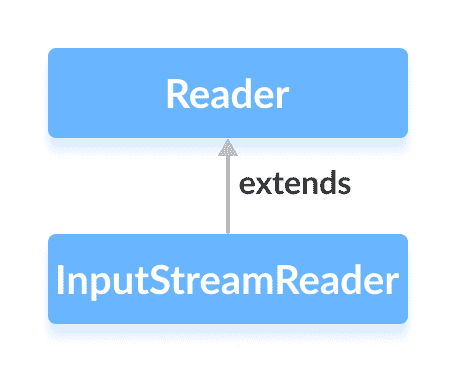原文: https://www.programiz.com/java-programming/inputstreamreader
在本教程中,我们将借助示例学习 Java InputStreamReader及其方法。
java.io包的InputStreamReader类可用于将字节数据转换为字符数据。
它扩展了抽象类Reader。

InputStreamReader类可与其他输入流一起使用。 它也被称为字节流和字符流之间的桥梁。 这是因为InputStreamReader从输入流中读取字节作为字符。
例如,某些字符需要 2 个字节才能存储在存储器中。 要读取此类数据,我们可以使用输入流读取器,该读取器一起读取 2 个字节并将其转换为相应的字符。
创建一个InputStreamReader
为了创建一个InputStreamReader,我们必须首先导入java.io.InputStreamReader包。 导入包后,就可以在这里创建输入流读取器。
// Creates an InputStreamFileInputStream file = new FileInputStream(String path);// Creates an InputStreamReaderInputStreamReader input = new InputStreamReader(file);
在上面的示例中,我们创建了一个名为input的InputStreamReader以及名为file的FileInputStream。
在这里,文件中的数据使用某些默认字符编码存储。
但是,我们也可以在文件中指定字符编码的类型(UTF8 或 UTF16)。
// Creates an InputStreamReader specifying the character encodingInputStreamReader input = new InputStreamReader(file, Charset cs);
在这里,我们使用了Charset类来指定文件中的字符编码。
InputStreamReader的方法
InputStreamReader类提供了Reader类中存在的不同方法的实现。
read()方法
read()- 从读取器读取单个字符read(char[] array)- 从读取器读取字符并将其存储在指定的数组中read(char[] array, int start, int length)- 从读取器中读取等于length的字符数,并从start开始存储在指定的数组中
例如,假设我们有一个名为input.txt的文件,其内容如下。
This is a line of text inside the file.
让我们尝试使用InputStreamReader读取此文件。
import java.io.InputStreamReader;import java.io.FileInputStream;class Main {public static void main(String[] args) {// Creates an array of characterchar[] array = new char[100];try {// Creates a FileInputStreamFileInputStream file = new FileInputStream("input.txt");// Creates an InputStreamReaderInputStreamReader input = new InputStreamReader(file);// Reads characters from the fileinput.read(array);System.out.println("Data in the stream:");System.out.println(array);// Closes the readerinput.close();}catch(Exception e) {e.getStackTrace();}}}
输出
Data in the stream:This is a line of text inside the file.
在上面的示例中,我们使用文件输入流创建了一个输入流读取器。 输入流读取器与文件input.txt链接。
FileInputStream file = new FileInputStream("input.txt");InputStreamReader input = new InputStreamReader(file);
要从文件中读取字符,我们使用了read()方法。
getEncoding()方法
getEncoding()方法可用于获取用于在输入流中存储数据的编码类型。 例如,
import java.io.InputStreamReader;import java.nio.charset.Charset;import java.io.FileInputStream;class Main {public static void main(String[] args) {try {// Creates a FileInputStreamFileInputStream file = new FileInputStream("input.txt");// Creates an InputStreamReader with default encodingInputStreamReader input1 = new InputStreamReader(file);// Creates an InputStreamReader specifying the encodingInputStreamReader input2 = new InputStreamReader(file, Charset.forName("UTF8"));// Returns the character encoding of the input streamSystem.out.println("Character encoding of input1: " + input1.getEncoding());System.out.println("Character encoding of input2: " + input2.getEncoding());// Closes the readerinput1.close();input2.close();}catch(Exception e) {e.getStackTrace();}}}
输出:
The character encoding of input1: Cp1252The character encoding of input2: UTF8
在上面的示例中,我们创建了两个输入流读取器,分别名为input1和input2。
input1未指定字符编码。 因此,getEncoding()方法返回默认字符编码的规范名称。input2指定字符编码 UTF8。 因此,getEncoding()方法返回指定的字符编码。
注意:我们已经使用Charset.forName()方法来指定字符编码的类型。 要了解更多信息,请访问 Java Charset(Java 官方文档)。
close()方法
要关闭输入流读取器,我们可以使用close()方法。 调用close()方法后,我们将无法使用读取器读取数据。
InputStreamReader的其他方法
| 方法 | 描述 |
|---|---|
ready() |
检查流是否准备好被读取 |
mark() |
标记流中已读取数据的位置 |
reset() |
将控件返回到流中设置标记的点 |
要了解更多信息,请访问 Java InputStreamReader(官方 Java 文档)。

